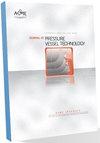高温核设施用包壳部件的设计。第一部分:分析方法
IF 1.4
4区 工程技术
Q4 ENGINEERING, MECHANICAL
Journal of Pressure Vessel Technology-Transactions of the Asme
Pub Date : 2022-09-02
DOI:10.1115/1.4055437
引用次数: 0
摘要
在许多先进的反应堆系统中,采用耐腐蚀包层可以大大延长结构部件的设计寿命。然而,目前还没有美国机械工程师协会(ASME)的设计规则来保护包覆部件在高温核服务中防止蠕变疲劳失效和棘轮应变积累。本文分为两部分,通过提出一种不需要对包覆材料进行长期测试的包覆组件的设计策略来解决这一差距。所提出的方法依赖于两种覆层材料的近似设计分析方法-软覆层比a类基材蠕变快得多且屈服应力更低,硬覆层比a类基材蠕变慢得多且屈服应力更高。第1部分讨论了覆层材料的近似分析策略——将软覆层视为完全柔性,将硬覆层视为线性弹性——第2部分为两种类型的覆层组件开发了一套完整的设计规则。对具有代表性的高温反应堆部件的有限元分析表明,所提出的设计分析方法能够约束软包覆件的设计量,逼近硬包覆件的设计量。本文章由计算机程序翻译,如有差异,请以英文原文为准。
Designing Cladded Components for High Temperature Nuclear Service. Part-1: Analysis Methods
Use of corrosion resistant cladding can greatly extend the design life of structural components in many advanced reactor systems. However, there are currently no ASME design rules for cladded components to guard against creep-fatigue failure and ratcheting strain accumulation in elevated temperature nuclear service. This paper, presented in two parts, addresses this gap by proposing a design strategy for cladded components that does not require long-term testing of clad materials. The proposed approach relies on approximate design analysis methods for two types of clad materials - a soft clad that creeps much faster than and has a lower yield stress than the Class A base material and a hard clad that creeps much slower than and has a higher yield stress than the Class A base material. This Part 1 discusses the approximate analysis strategies for the clad materials - treat a soft clad as perfectly compliant and a hard clad as linear elastic - and Part 2 develops a complete set of design rules for each of the two types of cladded components. Finite element analyses of representative high temperature reactor components show that the proposed design analysis methods can bound the design quantities in soft cladded components and approximate the design quantities in hard cladded components.
求助全文
通过发布文献求助,成功后即可免费获取论文全文。
去求助
来源期刊
CiteScore
2.10
自引率
10.00%
发文量
77
审稿时长
4.2 months
期刊介绍:
The Journal of Pressure Vessel Technology is the premier publication for the highest-quality research and interpretive reports on the design, analysis, materials, fabrication, construction, inspection, operation, and failure prevention of pressure vessels, piping, pipelines, power and heating boilers, heat exchangers, reaction vessels, pumps, valves, and other pressure and temperature-bearing components, as well as the nondestructive evaluation of critical components in mechanical engineering applications. Not only does the Journal cover all topics dealing with the design and analysis of pressure vessels, piping, and components, but it also contains discussions of their related codes and standards.
Applicable pressure technology areas of interest include: Dynamic and seismic analysis; Equipment qualification; Fabrication; Welding processes and integrity; Operation of vessels and piping; Fatigue and fracture prediction; Finite and boundary element methods; Fluid-structure interaction; High pressure engineering; Elevated temperature analysis and design; Inelastic analysis; Life extension; Lifeline earthquake engineering; PVP materials and their property databases; NDE; safety and reliability; Verification and qualification of software.

 求助内容:
求助内容: 应助结果提醒方式:
应助结果提醒方式:


